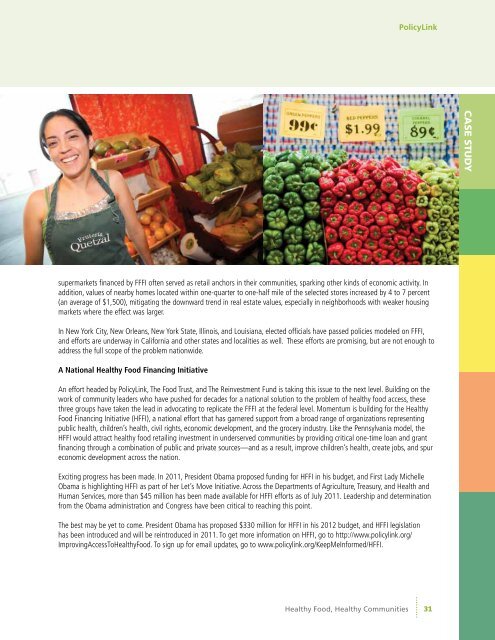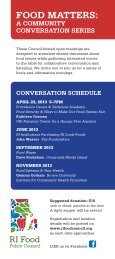Promising Strategies to Improve Access to Fresh, Healthy Food and ...
Promising Strategies to Improve Access to Fresh, Healthy Food and ...
Promising Strategies to Improve Access to Fresh, Healthy Food and ...
You also want an ePaper? Increase the reach of your titles
YUMPU automatically turns print PDFs into web optimized ePapers that Google loves.
PolicyLinkCASE STUDYsupermarkets financed by FFFI often served as retail anchors in their communities, sparking other kinds of economic activity. Inaddition, values of nearby homes located within one-quarter <strong>to</strong> one-half mile of the selected s<strong>to</strong>res increased by 4 <strong>to</strong> 7 percent(an average of $1,500), mitigating the downward trend in real estate values, especially in neighborhoods with weaker housingmarkets where the effect was larger.In New York City, New Orleans, New York State, Illinois, <strong>and</strong> Louisiana, elected officials have passed policies modeled on FFFI,<strong>and</strong> efforts are underway in California <strong>and</strong> other states <strong>and</strong> localities as well. These efforts are promising, but are not enough <strong>to</strong>address the full scope of the problem nationwide.A National <strong>Healthy</strong> <strong>Food</strong> Financing InitiativeAn effort headed by PolicyLink, The <strong>Food</strong> Trust, <strong>and</strong> The Reinvestment Fund is taking this issue <strong>to</strong> the next level. Building on thework of community leaders who have pushed for decades for a national solution <strong>to</strong> the problem of healthy food access, thesethree groups have taken the lead in advocating <strong>to</strong> replicate the FFFI at the federal level. Momentum is building for the <strong>Healthy</strong><strong>Food</strong> Financing Initiative (HFFI), a national effort that has garnered support from a broad range of organizations representingpublic health, children’s health, civil rights, economic development, <strong>and</strong> the grocery industry. Like the Pennsylvania model, theHFFI would attract healthy food retailing investment in underserved communities by providing critical one-time loan <strong>and</strong> grantfinancing through a combination of public <strong>and</strong> private sources—<strong>and</strong> as a result, improve children’s health, create jobs, <strong>and</strong> spureconomic development across the nation.Exciting progress has been made. In 2011, President Obama proposed funding for HFFI in his budget, <strong>and</strong> First Lady MichelleObama is highlighting HFFI as part of her Let’s Move Initiative. Across the Departments of Agriculture, Treasury, <strong>and</strong> Health <strong>and</strong>Human Services, more than $45 million has been made available for HFFI efforts as of July 2011. Leadership <strong>and</strong> determinationfrom the Obama administration <strong>and</strong> Congress have been critical <strong>to</strong> reaching this point.The best may be yet <strong>to</strong> come. President Obama has proposed $330 million for HFFI in his 2012 budget, <strong>and</strong> HFFI legislationhas been introduced <strong>and</strong> will be reintroduced in 2011. To get more information on HFFI, go <strong>to</strong> http://www.policylink.org/Improving<strong>Access</strong>To<strong>Healthy</strong><strong>Food</strong>. To sign up for email updates, go <strong>to</strong> www.policylink.org/KeepMeInformed/HFFI.<strong>Healthy</strong> <strong>Food</strong>, <strong>Healthy</strong> Communities31



